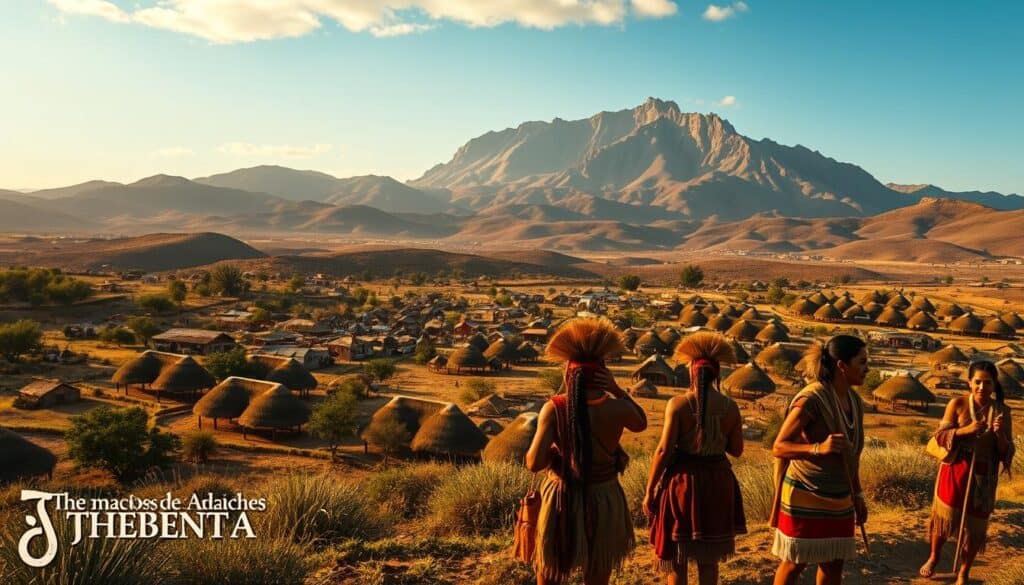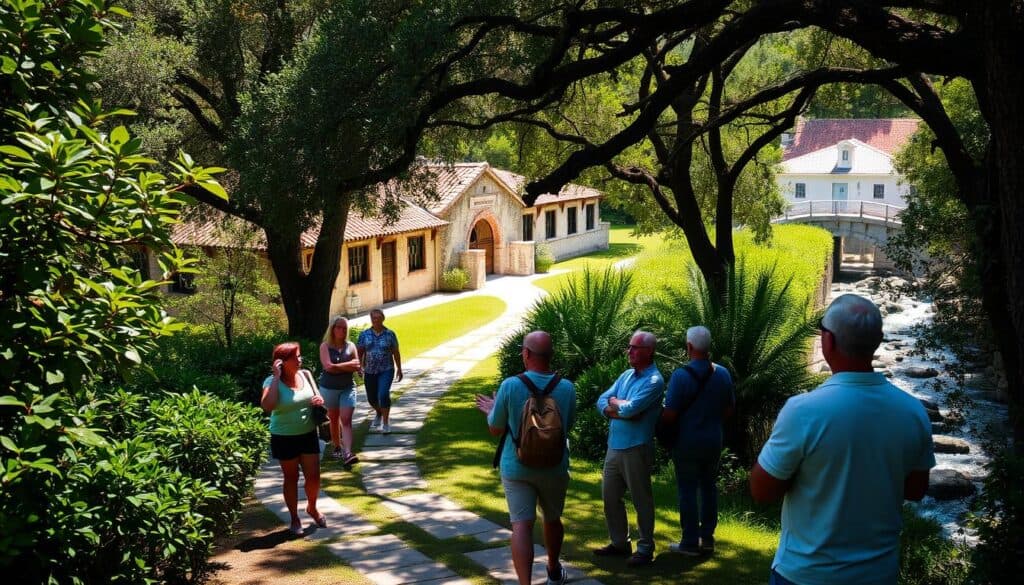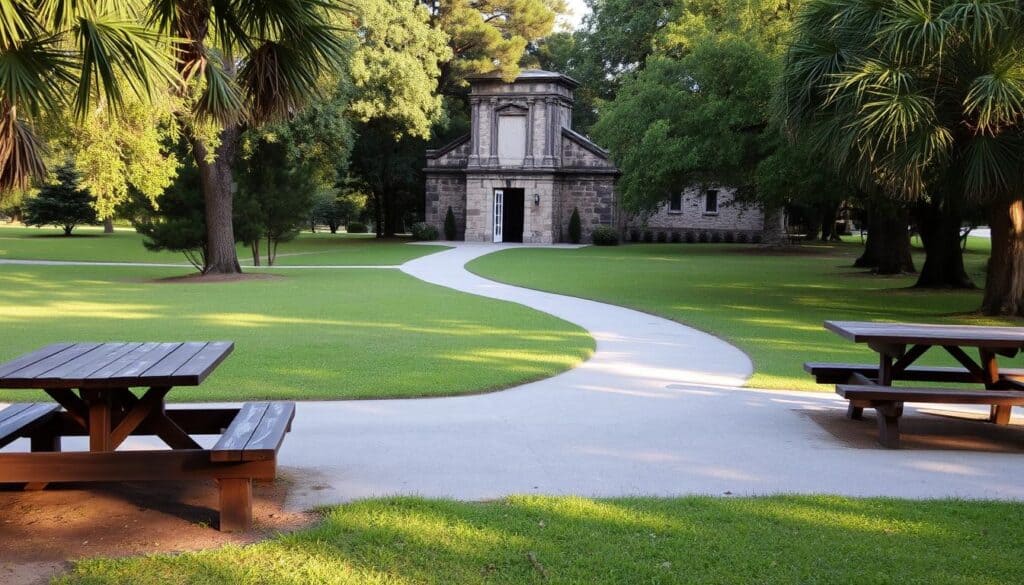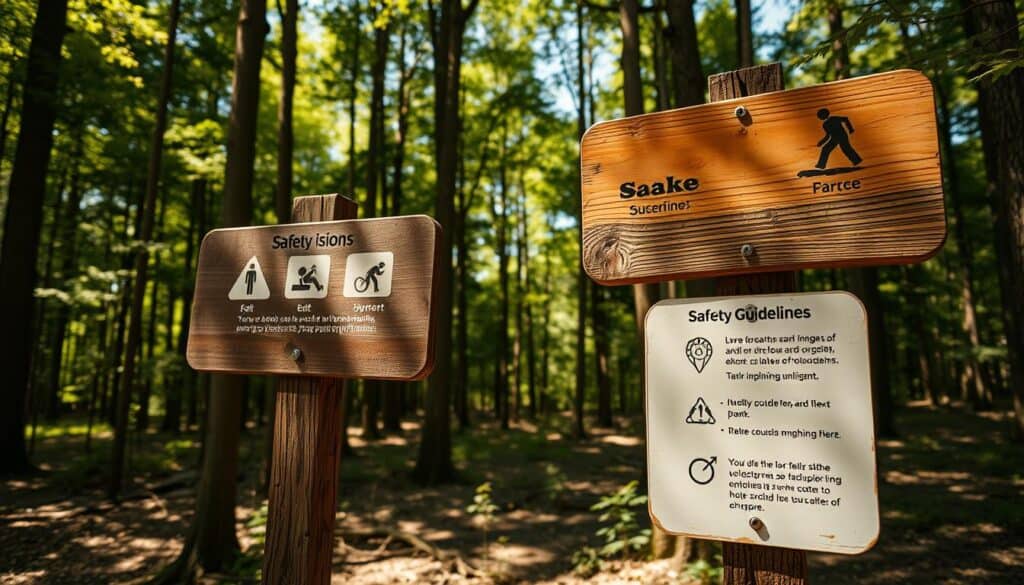Located at 30.1526° N, 84.2101° W, San Marcos de Apalache Historic State Park is a significant historical site with natural beauty, situated at the confluence of the St. Marks and Wakulla Rivers in Florida. This park offers a unique experience for visitors, blending Florida history with the stunning Gulf Coast setting. With its rich history dating back to the Spanish colonial settlement and its significance in Native American history, San Marcos de Apalache Historic State Park is a must-visit for anyone interested in exploring the depths of Florida’s past.
San Marcos de Apalache Historic State Park provides an opportunity to learn about Florida history while enjoying the beautiful Gulf Coast. The park’s historical sites and archaeological significance make it an ideal destination for those interested in history and nature. Visitors can explore the park’s interpretive trail, which is 0.6 miles long, and learn about the park’s history and significance.
Key Takeaways
- San Marcos de Apalache Historic State Park is located at the confluence of the St. Marks and Wakulla Rivers in Florida.
- The park offers a unique blend of Florida history and natural beauty.
- Visitors can explore the park’s interpretive trail and learn about its historical significance.
- The park is situated on the Gulf Coast, providing a stunning backdrop for its historical sites.
- San Marcos de Apalache Historic State Park is a must-visit for anyone interested in Florida history and the Gulf Coast.
- The park is open from Thursday to Monday, with a fee of $2 per person to visit the museum.
- The park’s location is 18 miles south of Tallahassee, making it easily accessible for visitors.
Introduction to San Marcos de Apalache Historic State Park
San Marcos de Apalache Historic State Park is a significant historical site that showcases the lives of the Apalachee tribe and the Spanish colonizers. The park’s location, at the tip of the peninsula where the St. Marks and Wakulla Rivers meet, made it a strategic point for both the Native Americans and the Spanish.
The park was once home to the Apalachee tribe, who inhabited the area before the arrival of the Spanish. The Spanish established a Spanish colonial settlement in the area, which later became an important location for trade and commerce. Today, visitors can explore the remnants of the Spanish fort and learn about the history of the Apalachee tribe and the Spanish colonizers.
Overview of the Park and Its Significance
The park is one of the most important historical sites in the region, providing a glimpse into the lives of the Apalachee tribe and the Spanish colonizers. The park’s significance is not only due to its historical importance but also due to its natural beauty, with the St. Marks and Wakulla Rivers providing a stunning backdrop to the park.
Location and Accessibility
The park is located in a strategic area, making it easily accessible to visitors. The park is situated near the Apalachee Bay, which is named after the Apalachee people who originally inhabited the area. The park’s location makes it an ideal destination for those interested in history, nature, and culture.
Some of the key features of the park include:
- Remnants of the Spanish fort
- Historical exhibits and artifacts
- Scenic views of the St. Marks and Wakulla Rivers
- Opportunities to learn about the Apalachee tribe and the Spanish colonizers
Overall, San Marcos de Apalache Historic State Park is a must-visit destination for anyone interested in history, nature, and culture. The park’s unique blend of historical significance and natural beauty makes it an ideal destination for families, historians, and nature lovers alike.
| Feature | Description |
|---|---|
| Historical Significance | The park is one of the most important historical sites in the region, providing a glimpse into the lives of the Apalachee tribe and the Spanish colonizers. |
| Natural Beauty | The park is situated near the Apalachee Bay and the St. Marks and Wakulla Rivers, providing a stunning backdrop to the park. |
| Accessibility | The park is located in a strategic area, making it easily accessible to visitors. |
History of San Marcos de Apalache
The history of San Marcos de Apalache is a rich and complex one, reflecting the various cultures that have inhabited the area. From the early days of the Apalachee tribe to the arrival of the Spanish and later the British, the park has been a site of significant historical events. The archaeological significance of the site is evident in the remnants of the Spanish fort and the artifacts found during excavations.
Understanding the park’s history provides a deeper appreciation for its importance in the broader context of Native American history. The park has a long and storied past, with evidence of early indigenous inhabitation, Spanish and British colonial influence, and significant historical events. Some of the key events in the park’s history include:
- The construction of three Spanish forts between 1679 and 1821
- The destruction of several Spanish missions by the British in the early 18th century
- The construction of a large stone fort in 1739, which was never completed
- The occupation of the fort by Confederate troops during the Civil War
The park’s history is a testament to the complex and often tumultuous relationship between European colonizers and Native American tribes. Today, the park is a National Historic Landmark, reflecting its significance in American history. Visitors can explore the park’s museum and learn more about its rich and fascinating history.

Exploring the Natural Landscape
The Gulf Coast location of San Marcos de Apalache Historic State Park provides a unique natural landscape with diverse ecosystems. The park’s surroundings, featuring the confluence of the St. Marks and Wakulla Rivers, create a haven for nature lovers and support a wide range of biodiversity.
The park is situated in an area known for its natural beauty, making it an ideal spot for outdoor activities such as birdwatching, fishing, and hiking. The Gulf Coast ecosystem is home to a variety of flora and fauna, and the park’s natural landscape offers a unique opportunity to experience this ecosystem up close.
Some of the notable features of the park’s natural landscape include its diverse range of plant and animal species. The park is home to a wide range of wildlife, including birds, fish, and other animals that are adapted to the Gulf Coast ecosystem. The park’s natural beauty and unique ecosystems make it a must-visit destination for anyone interested in exploring the natural landscape of the Gulf Coast.
Recreational Activities Available
San Marcos de Apalache Historic State Park offers a wide range of recreational activities for visitors to enjoy. From hiking and birdwatching to fishing and exploring the rivers, there’s something for everyone to experience and connect with nature. The park’s diverse landscape and ecosystems provide a unique setting for outdoor enthusiasts to engage in their favorite activities.
Some of the popular recreational activities available in the park include:
- Hiking on trails that wind through the park’s natural beauty, offering glimpses of its historical sites along the way
- Birdwatching, with the park being a stopover for many species of birds
- Fishing and exploring the rivers, providing a chance to connect with nature and perhaps catch a glimpse of the local wildlife
These recreational activities, including hiking trails and birdwatching, are a great way to experience the park’s natural beauty and learn about its history and ecology. Whether you’re a nature lover, a history buff, or just looking for a fun outdoor activity, San Marcos de Apalache Historic State Park has something to offer. The park’s recreational activities are designed to be enjoyable for all ages and skill levels, making it an ideal destination for families and groups.
Guided Tours and Educational Programs
San Marcos de Apalache Historic State Park offers a range of guided tours and educational programs to enhance the visitor experience. These programs provide insights into the park’s history, highlighting its most significant historical sites and sharing stories about the people who once lived there. By participating in these guided tours, visitors can gain a deeper understanding of the park’s historical significance and its importance in the region.
The park’s educational programs are perfect for families or schools looking to learn more about Florida’s history and natural environment in an engaging and interactive way. Some of the programs available include workshops, lectures, and hands-on activities that cater to different age groups and interests. For example, the park offers guided tours led by knowledgeable park rangers, which cover topics such as the park’s history, wildlife, and conservation efforts.
Park Tours and Workshops
Some of the notable guided tours and educational programs available at the park include:
- Guided tours of the park’s historical sites, including the fort and the museum
- Workshops on topics such as historic crafts, wildlife conservation, and environmental education
- Lectures on the park’s history, geology, and natural environment
- Hands-on activities, such as nature walks, birdwatching, and outdoor games
These programs are designed to be engaging, informative, and fun, making them an excellent way to learn about the park’s history and natural environment. By participating in these guided tours and educational programs, visitors can gain a deeper appreciation for the park’s significance and importance in the region.

In addition to the park’s guided tours and educational programs, there are also several other educational institutions and historical sites in the area that offer similar programs and activities. These include the Challenger Learning Center, the FSU Museum of Fine Arts, and the Museum of Florida History, among others. By visiting these sites and participating in their programs, visitors can gain a more comprehensive understanding of the region’s history, culture, and natural environment.
| Program | Description |
|---|---|
| Guided Tours | Guided tours of the park’s historical sites, including the fort and the museum |
| Workshops | Workshops on topics such as historic crafts, wildlife conservation, and environmental education |
| Lectures | Lectures on the park’s history, geology, and natural environment |
Visitor Amenities and Facilities
The San Marcos de Apalache Historic State Park offers a range of visitor amenities to ensure a comfortable and enjoyable experience for all guests. One of the highlights of the park is its picnic areas, where families and friends can gather to enjoy meals surrounded by the natural beauty of the park.
In addition to the picnic areas, the park provides convenient accessibility options, including accessible parking and pathways, making it easy for everyone to explore the historical sites and natural landscapes. The park’s facilities, including restrooms, are designed to be accessible and convenient for all visitors.

Some of the key amenities and facilities available at the park include:
- Picnic areas with tables and benches
- Accessible parking and pathways
- Restrooms and potable water
These amenities and facilities are designed to enhance the overall visitor experience, making it easy for everyone to enjoy the park’s natural beauty and historical significance.
Safety Guidelines for Visitors
When visiting San Marcos de Apalache Historic State Park, it’s essential to prioritize your safety and the safety of the wildlife that inhabits the area. The park provides safety guidelines to help you navigate the terrain and interact with wildlife safely.
To ensure a safe and enjoyable visit, it’s crucial to be aware of potential wildlife encounters. The park is home to various species, including alligators, snakes, and birds. Keep a safe distance from wildlife, and never feed or approach them.
In addition to wildlife encounters, weather preparedness is vital. Florida’s weather can be unpredictable, with sudden thunderstorms and extreme heat. Stay informed about weather conditions, and take necessary precautions, such as bringing sunscreen, a hat, and plenty of water.
Some key safety guidelines to keep in mind include:
- Stay on designated trails and avoid wandering into dense vegetation
- Keep a safe distance from wildlife and never feed or approach them
- Be prepared for changing weather conditions and take necessary precautions

Special Events at the Park
San Marcos de Apalache Historic State Park is a hub of activity throughout the year, with a wide range of special events that cater to all interests. From annual festivals that bring the community together to seasonal events that highlight the park’s unique aspects, there’s always something happening at the park. These events are a great way to experience the park in a new light, whether you’re a regular visitor or just discovering its charms.
The park hosts various special events and festivals that celebrate its history, culture, and natural beauty. Some of the notable events include the Coastal Cleanups, which occur annually, and the Manatee Springs Christmas Festival, which features 150,000 lights illuminating the park and a 50-ft Christmas tree lit at 6 p.m. The park also offers seasonal events such as the Twilight Cruise, which is priced at $24 per person, and the Nature’s Gallery event, which offers free parking.
Some of the other annual festivals and events at the park include the Labor Day Treasure Hunt, the Scallop Day Festival, and the New Year’s Eve Gala. The park also offers guided tours, including the Ranger-led tours, which provide daily interpretations during specific months. The park’s events are designed to be fun and educational, making them a great way to spend time with family and friends while learning about the park’s history and natural environment.
Here are some of the upcoming events at the park:
- Coastal Cleanups: September 19 at Perdido Key and Big Lagoon
- Manatee Springs Christmas Festival: features 150,000 lights illuminating the park
- Twilight Cruise: priced at $24 per person, with several scheduled throughout the fall
- Nature’s Gallery event: offers free parking on November 14 & 15
Conservation Efforts and Volunteer Opportunities
Conservation Efforts and Volunteer Opportunities
San Marcos de Apalache Historic State Park is dedicated to preserving its natural and historical resources through various conservation efforts. Visitors can contribute to these efforts by participating in volunteer opportunities and community engagement programs. These programs offer a chance to make a positive impact on the park’s ecosystem and historical sites.
Some ways to get involved include:
- Assisting with wildlife conservation projects
- Participating in archaeological excavations
- Helping with park maintenance and upkeep
By participating in these conservation efforts and volunteer opportunities, visitors can help protect the park’s unique resources and ensure their preservation for future generations. The park’s community engagement programs also provide a chance to connect with like-minded individuals and learn more about the park’s history and ecology.
For those interested in getting involved, the park offers a range of programs and activities to suit different interests and skill levels. Whether you’re a nature lover, history buff, or simply looking for a way to give back, there’s something for everyone at San Marcos de Apalache Historic State Park.
| Program | Description |
|---|---|
| Wildlife Conservation | Assist with projects to protect and preserve the park’s wildlife |
| Archaeological Excavations | Participate in excavations to uncover the park’s historical secrets |
| Park Maintenance | Help with upkeep and maintenance of the park’s facilities and trails |
Planning Your Visit to San Marcos de Apalache
As you prepare to visit San Marcos de Apalache Historic State Park, consider the best times to explore this remarkable historical site. The park is open from Thursday to Monday, with operating hours from 9 AM to 5 PM, offering ample opportunities to discover its rich past. While the park is closed on major holidays, the mild winter and spring months in Florida often provide the most comfortable weather for outdoor adventures.
For first-time visitors, it’s recommended to start your journey at the on-site museum. Here, you can gain a comprehensive overview of the park’s significance, from its early indigenous inhabitation to its pivotal role during the Spanish and British colonial eras. After familiarizing yourself with the history, venture out to explore the trails and historical landmarks, keeping an eye out for the area’s unique flora and fauna.
Before you embark on your visit, be sure to check the park’s website for any special events or temporary closures. Dress comfortably, pack sunscreen, and embrace the spirit of exploration as you uncover the captivating stories that define San Marcos de Apalache Historic State Park.
